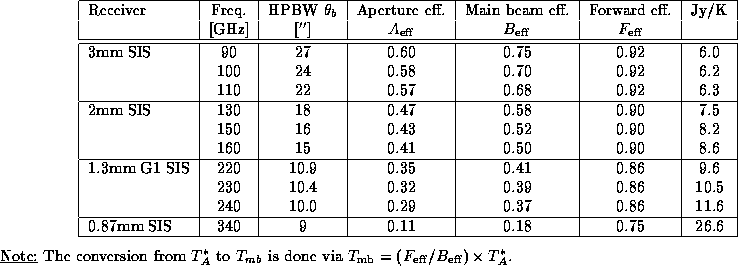



Next: Receiver characteristics
Up: Cookbook Formulae for
Previous: Foreword
In order to estimate the observing time needed to detect a signal of a given
intensity, its flux density  (or `beam averaged brightness temperature'
(or `beam averaged brightness temperature'
 ) has to be converted in antenna temperature units. This is done
e.g. by multiplying
) has to be converted in antenna temperature units. This is done
e.g. by multiplying  or
or  by the telescope efficiency.
Different efficiencies should be used, depending on the size of the source
relative to the telescope beam: the aperture efficiency
by the telescope efficiency.
Different efficiencies should be used, depending on the size of the source
relative to the telescope beam: the aperture efficiency  , the main-beam
efficiency
, the main-beam
efficiency  , the `Moon' efficiency
, the `Moon' efficiency  . Another relevant efficiency
is the `telescope forward efficiency'
. Another relevant efficiency
is the `telescope forward efficiency'  , which depends on the coupling of
the `receiver' with the cold sky, and which can be measured during excellent
weather conditions by tipping the antenna (SKYDIP --beware however that your
, which depends on the coupling of
the `receiver' with the cold sky, and which can be measured during excellent
weather conditions by tipping the antenna (SKYDIP --beware however that your
 is correct!).
is correct!).
The various efficiencies are listed in columns 4--6 of Table 1.
The aperture efficiencies were derived from continuum cross scans of Mars and
Uranus carried
out between March, 17th and August, 15th, 1994. The planetary diameters during
this period ranged between  and
and  . A (theoretical) correction was
made for the antenna gain-elevation dependence. This correction was at most
7% for this data set.
. A (theoretical) correction was
made for the antenna gain-elevation dependence. This correction was at most
7% for this data set.
The third and last columns of Table 1 give the telescope
half-power beamwidth and the flux density to antenna temperature ratio for a
point source,  (in Jy/K). This latter is calculated from the
formula
(in Jy/K). This latter is calculated from the
formula  , where the numerical factor
stands for
, where the numerical factor
stands for  . Values for the Moon efficiency
. Values for the Moon efficiency  are
in preparation. Note that in order to convert the `antenna' temperatures
are
in preparation. Note that in order to convert the `antenna' temperatures
 given by OBS into main-beam averaged `Raleigh-Jeans brightness
temperatures' (or `radiation' temperatures),
given by OBS into main-beam averaged `Raleigh-Jeans brightness
temperatures' (or `radiation' temperatures),  , the former have to
be to be multiplied by
, the former have to
be to be multiplied by  (assuming the source does not extend
outside the telescope main beam).
(assuming the source does not extend
outside the telescope main beam).

Table: 30m Telescope efficiencies
Robert Lucas
Thu Mar 9 12:14:01 MET 1995
 (or `beam averaged brightness temperature'
(or `beam averaged brightness temperature'
 ) has to be converted in antenna temperature units. This is done
e.g. by multiplying
) has to be converted in antenna temperature units. This is done
e.g. by multiplying  or
or  by the telescope efficiency.
Different efficiencies should be used, depending on the size of the source
relative to the telescope beam: the aperture efficiency
by the telescope efficiency.
Different efficiencies should be used, depending on the size of the source
relative to the telescope beam: the aperture efficiency  , the main-beam
efficiency
, the main-beam
efficiency  , the `Moon' efficiency
, the `Moon' efficiency  . Another relevant efficiency
is the `telescope forward efficiency'
. Another relevant efficiency
is the `telescope forward efficiency'  , which depends on the coupling of
the `receiver' with the cold sky, and which can be measured during excellent
weather conditions by tipping the antenna (SKYDIP --beware however that your
, which depends on the coupling of
the `receiver' with the cold sky, and which can be measured during excellent
weather conditions by tipping the antenna (SKYDIP --beware however that your
 is correct!).
is correct!).




 and
and  . A (theoretical) correction was
made for the antenna gain-elevation dependence. This correction was at most
7% for this data set.
. A (theoretical) correction was
made for the antenna gain-elevation dependence. This correction was at most
7% for this data set.
 (in Jy/K). This latter is calculated from the
formula
(in Jy/K). This latter is calculated from the
formula  , where the numerical factor
stands for
, where the numerical factor
stands for  . Values for the Moon efficiency
. Values for the Moon efficiency  are
in preparation. Note that in order to convert the `antenna' temperatures
are
in preparation. Note that in order to convert the `antenna' temperatures
 given by OBS into main-beam averaged `Raleigh-Jeans brightness
temperatures' (or `radiation' temperatures),
given by OBS into main-beam averaged `Raleigh-Jeans brightness
temperatures' (or `radiation' temperatures),  , the former have to
be to be multiplied by
, the former have to
be to be multiplied by  (assuming the source does not extend
outside the telescope main beam).
(assuming the source does not extend
outside the telescope main beam).
